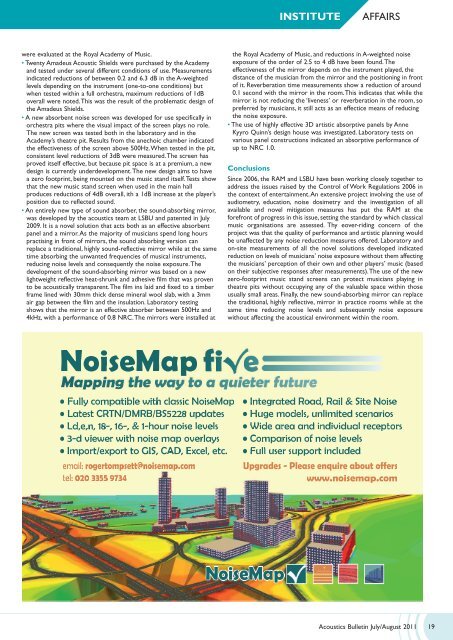Acoustics Bulletin Jul-Aug 2011 - Institute of Acoustics
Acoustics Bulletin Jul-Aug 2011 - Institute of Acoustics
Acoustics Bulletin Jul-Aug 2011 - Institute of Acoustics
Create successful ePaper yourself
Turn your PDF publications into a flip-book with our unique Google optimized e-Paper software.
INSTITUTE<br />
AFFAIRS<br />
were evaluated at the Royal Academy <strong>of</strong> Music.<br />
• Twenty Amadeus Acoustic Shields were purchased by the Academy<br />
and tested under several different conditions <strong>of</strong> use. Measurements<br />
indicated reductions <strong>of</strong> between 0.2 and 6.3 dB in the A-weighted<br />
levels depending on the instrument (one-to-one conditions) but<br />
when tested within a full orchestra, maximum reductions <strong>of</strong> 1dB<br />
overall were noted. This was the result <strong>of</strong> the problematic design <strong>of</strong><br />
the Amadeus Shields.<br />
• A new absorbent noise screen was developed for use specifically in<br />
orchestra pits where the visual impact <strong>of</strong> the screen plays no role.<br />
The new screen was tested both in the laboratory and in the<br />
Academy’s theatre pit. Results from the anechoic chamber indicated<br />
the effectiveness <strong>of</strong> the screen above 500Hz. When tested in the pit,<br />
consistent level reductions <strong>of</strong> 3dB were measured. The screen has<br />
proved itself effective, but because pit space is at a premium, a new<br />
design is currently underdevelopment. The new design aims to have<br />
a zero footprint, being mounted on the music stand itself. Tests show<br />
that the new music stand screen when used in the main hall<br />
produces reductions <strong>of</strong> 4dB overall, ith a 1dB increase at the player’s<br />
position due to reflected sound.<br />
• An entirely new type <strong>of</strong> sound absorber, the sound-absorbing mirror,<br />
was developed by the acoustics team at LSBU and patented in <strong>Jul</strong>y<br />
2009. It is a novel solution that acts both as an effective absorbent<br />
panel and a mirror. As the majority <strong>of</strong> musicians spend long hours<br />
practising in front <strong>of</strong> mirrors, the sound absorbing version can<br />
replace a traditional, highly sound-reflective mirror while at the same<br />
time absorbing the unwanted frequencies <strong>of</strong> musical instruments,<br />
reducing noise levels and consequently the noise exposure. The<br />
development <strong>of</strong> the sound-absorbing mirror was based on a new<br />
lightweight reflective heat-shrunk and adhesive film that was proven<br />
to be acoustically transparent. The film ins laid and fixed to a timber<br />
frame lined with 30mm thick dense mineral wool slab, with a 3mm<br />
air gap between the film and the insulation. Laboratory testing<br />
shows that the mirror is an effective absorber between 500Hz and<br />
4kHz, with a performance <strong>of</strong> 0.8 NRC. The mirrors were installed at<br />
the Royal Academy <strong>of</strong> Music, and reductions in A-weighted noise<br />
exposure <strong>of</strong> the order <strong>of</strong> 2.5 to 4 dB have been found. The<br />
effectiveness <strong>of</strong> the mirror depends on the instrument played, the<br />
distance <strong>of</strong> the musician from the mirror and the positioning in front<br />
<strong>of</strong> it. Reverberation time measurements show a reduction <strong>of</strong> around<br />
0.1 second with the mirror in the room. This indicates that while the<br />
mirror is not reducing the ‘liveness’ or reverberation in the room, so<br />
preferred by musicians, it still acts as an effectice means <strong>of</strong> reducing<br />
the noise exposure.<br />
• The use <strong>of</strong> highly effective 3D artistic absorptive panels by Anne<br />
Kyyro Quinn’s design house was investigated. Laboratory tests on<br />
various panel constructions indicated an absorptive performance <strong>of</strong><br />
up to NRC 1.0.<br />
Conclusions<br />
Since 2006, the RAM and LSBU have been working closely together to<br />
address the issues raised by the Control <strong>of</strong> Work Regulations 2006 in<br />
the context <strong>of</strong> entertainment. An extensive project involving the use <strong>of</strong><br />
audiometry, education, noise dosimetry and the investigation <strong>of</strong> all<br />
available and novel mitigation measures has put the RAM at the<br />
forefront <strong>of</strong> progress in this issue, setting the standard by which classical<br />
music organisations are assessed. Thy eover-riding concern <strong>of</strong> the<br />
project was that the quality <strong>of</strong> performance and artistic planning would<br />
be unaffected by any noise reduction measures <strong>of</strong>fered. Laboratory and<br />
on-site measurements <strong>of</strong> all the novel solutions developed indicated<br />
reduction on levels <strong>of</strong> musicians’ noise exposure without them affecting<br />
the musicians’ perception <strong>of</strong> their own and other players’ music (based<br />
on their subjective responses after measurements). The use <strong>of</strong> the new<br />
zero-footprint music stand screens can protect musicians playing in<br />
theatre pits without occupying any <strong>of</strong> the valuable space within those<br />
usually small areas. Finally, the new sound-absorbing mirror can replace<br />
the traditional, highly reflective, mirror in practice rooms while at the<br />
same time reducing noise levels and subsequently noise exposure<br />
without affecting the acoustical environment within the room.<br />
NoiseMap<br />
• Fully compatible with classic NoiseMap<br />
• Latest CRTN/DMRB/BS5228 updates<br />
• Ld,e,n, 18-, 16-, & 1-hour noise levels<br />
• 3-d viewer with noise map overlays<br />
• Import/export to GIS, CAD, Excel, etc.<br />
email: rogertompsett@noisemap.com<br />
tel: 020 3355 9734<br />
• Integrated Road, Rail & Site Noise<br />
• Huge models, unlimited scenarios<br />
• Wide area and individual receptors<br />
• Comparison <strong>of</strong> noise levels<br />
• Full user support included<br />
Upgrades - Please enquire about <strong>of</strong>fers<br />
www.noisemap.com<br />
NoiseMap<br />
<strong>Acoustics</strong> <strong>Bulletin</strong> <strong>Jul</strong>y/<strong>Aug</strong>ust <strong>2011</strong> 19

















